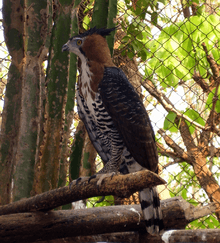Ornate hawk-eagle
| Ornate hawk-eagle | |
|---|---|
 | |
| Adult, Federal University of Mato Grosso zoo, Cuiabá (Brazil) | |
| Scientific classification | |
| Kingdom: | Animalia |
| Phylum: | Chordata |
| Class: | Aves |
| Order: | Accipitriformes |
| Family: | Accipitridae |
| Genus: | Spizaetus |
| Species: | S. ornatus |
| Binomial name | |
| Spizaetus ornatus (Daudin, 1800) | |
The ornate hawk-eagle (Spizaetus ornatus) is a bird of prey from the tropical Americas. Like all eagles, it is in the family Accipitridae. This species is notable for its vivid colors, which differ markedly between adult and immature birds.

This is a medium-large raptor, at about 56.0–68.5 cm (22.0–27.0 in) in length, 117–142 cm (46–56 in) across the wings, and weighing about 960–1,650 g (2.12–3.64 lb). It has a prominent pointed crest, raised when excited, a black bill, broad wings, and a long, rounded tail.
The typical adult has blackish upper parts and crown, bright chestnut sides to the neck and breast, and a black-edged white throat and central breast. The rest of the under parts and feathered legs are white barred with black, and the tail has broad black bars. The under wings are white, with barred flight feathers; due to the heavy pattern, birds usually look rather dark in flight.
Sexes are similar, but young birds have a white head and under parts, with a grey crest, brown upper parts, and barring only on the flanks and legs.
The call is a high-pitched whee-oo whee-oo.
This bird is found in humid tropical forests from southern Mexico and the Yucatán Peninsula, to Trinidad and Tobago, south to Peru and Argentina. They are able to tolerate some degree of habitat fragmentation, breeding successfully near cities and in forest fragments as small as 200 ha (490 acres).[2] Despite a slender build and a body weight no greater than a large Buteo hawk, the ornate hawk-eagle is a notably powerful predator which, like other booted eagles, can take prey up to five times its own weight. Birds are the principal prey. Prey items have ranged in size from 180 g (6.3 oz) to 8 kg (18 lb) when taken. Prey species have included little blue herons, curassows, toucans, wood quail, pigeons, macaws, parrots, cotingas, chickens, and even a black vulture. Mammals are also significant prey, with agoutis, squirrels, rats, procyonids, and monkeys often taken. Reptiles are also occasionally hunted.[3]
The male's courtship display is a dive with folded wings, and a climb, sometimes completing a loop. The pair touch talons in flight as the female rolls on her back. This species builds a large stick nest in a high tree (e.g. Ceiba), many meters above ground. The nest is around 1 m (3.3 ft) in diameter. Most breeding activity occurs around April or May, differing slightly according to location; in Guatemala, breeding activity was observed from March to June, in Costa Rica in April and May, in Panama from November/December to May, and in the lowlands of Ecuador in March and April.[4]
Though locally rare, it was not considered a threatened species by the IUCN due to its wide range.[1][5] In 2012, the species was uplisted to Near Threatened.[6]
References
- 1 2 BirdLife International (2012). "Spizaetus ornatus". IUCN Red List of Threatened Species. Version 2013.2. International Union for Conservation of Nature. Retrieved 26 November 2013.
- ↑ Zorzin et al. (2006)
- ↑ "Raptors of the World" by Ferguson-Lees, Christie, Franklin, Mead & Burton. Houghton Mifflin (2001), ISBN 0-618-12762-3.
- ↑ Greeney et al. (2004)
- ↑ BLI (2004), Zorzin et al. (2006)
- ↑ "Recently recategorised species". Birdlife International (2012). Retrieved 15 June 2012.
Further reading
- ffrench, Richard; O'Neill, John Patton & Eckelberry, Don R. (1991): A guide to the birds of Trinidad and Tobago (2nd edition). Comstock Publishing, Ithaca, N.Y.. ISBN 0-8014-9792-2
- Greeney, Harold F.; Gelis, Rudolphe A. & White, Richard (2004): Notes on breeding birds from an Ecuadorian lowland forest. Bull. B.O.C. 124(1): 28-37. PDF fulltext
- Hilty, Steven L. (2003): Birds of Venezuela. Christopher Helm, London. ISBN 0-7136-6418-5
- Zorzin, Giancarlo; Carvalho, Carlos Eduardo Alencar; de Carvalho Filho, Eduardo Pio Mendes & Canuto, Marcus (2006): Novos registros de Falconiformes raros e ameaçados para o estado de Minas Gerais [New records of rare and threatened Falconiformes for the state of Minas Gerais]. Revista Brasileira de Ornitologia 14(4): 417-421 [Portuguese with English abstract]. PDF fulltext
External links
| Wikimedia Commons has media related to Spizaetus ornatus. |
- BirdLife Species Factsheet
- Stamps (for Belize, Colombia, El Salvador, Guyana, Honduras, Mexico, Nicaragua, Paraguay, and Venezuela)
- Ornate Hawk-Eagle photo gallery VIREO Photo-High Res
- Photo-Medium Res; Article birdwatchperu
- Photo-High Res; Article
